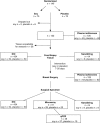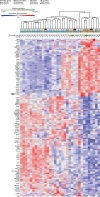The effects of soy supplementation on gene expression in breast cancer: a randomized placebo-controlled study
- PMID: 25190728
- PMCID: PMC4817128
- DOI: 10.1093/jnci/dju189
The effects of soy supplementation on gene expression in breast cancer: a randomized placebo-controlled study
Abstract
Background: There are conflicting reports on the impact of soy on breast carcinogenesis. This study examines the effects of soy supplementation on breast cancer-related genes and pathways.
Methods: Women (n = 140) with early-stage breast cancer were randomly assigned to soy protein supplementation (n = 70) or placebo (n = 70) for 7 to 30 days, from diagnosis until surgery. Adherence was determined by plasma isoflavones: genistein and daidzein. Gene expression changes were evaluated by NanoString in pre- and posttreatment tumor tissue. Genome-wide expression analysis was performed on posttreatment tissue. Proliferation (Ki67) and apoptosis (Cas3) were assessed by immunohistochemistry.
Results: Plasma isoflavones rose in the soy group (two-sided Wilcoxon rank-sum test, P < .001) and did not change in the placebo group. In paired analysis of pre- and posttreatment samples, 21 genes (out of 202) showed altered expression (two-sided Student's t-test, P < .05). Several genes including FANCC and UGT2A1 revealed different magnitude and direction of expression changes between the two groups (two-sided Student's t-test, P < .05). A high-genistein signature consisting of 126 differentially expressed genes was identified from microarray analysis of tumors. This signature was characterized by overexpression (>2-fold) of cell cycle transcripts, including those that promote cell proliferation, such as FGFR2, E2F5, BUB1, CCNB2, MYBL2, CDK1, and CDC20 (P < .01). Soy intake did not result in statistically significant changes in Ki67 or Cas3.
Conclusions: Gene expression associated with soy intake and high plasma genistein defines a signature characterized by overexpression of FGFR2 and genes that drive cell cycle and proliferation pathways. These findings raise the concerns that in a subset of women soy could adversely affect gene expression in breast cancer.
Trial registration: ClinicalTrials.gov NCT00597532.
© The Author 2014. Published by Oxford University Press. All rights reserved. For Permissions, please e-mail: journals.permissions@oup.com.
Figures





Comment in
-
Avoiding the bad and enhancing the good of soy supplements in breast cancer.J Natl Cancer Inst. 2014 Sep 4;106(9):dju233. doi: 10.1093/jnci/dju233. Print 2014 Sep. J Natl Cancer Inst. 2014. PMID: 25190729 Free PMC article. No abstract available.
References
-
- Messina M, McCaskill-Stevens W, Lampe JW. Addressing the soy and breast cancer relationship: review, commentary, and workshop proceedings. J Natl Cancer Inst. 2006;98(18):1275–1284. - PubMed
-
- Messina MJ, Loprinzi CL. Soy for breast cancer survivors: a critical review of the literature. J Nutr. 2001;131(11 Suppl):3095S–3108S. - PubMed
Publication types
MeSH terms
Substances
Associated data
Grants and funding
LinkOut - more resources
Full Text Sources
Other Literature Sources
Medical
Molecular Biology Databases
Miscellaneous

